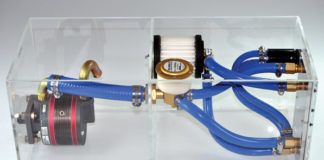
Compound Modifier
Yes, the turbo-compound engine written about by Paul Lamar [August 2009] does make a good deal of sense. It is no more complex than a turbo-supercharging system, and it increases the engines efficiency considerably. Why throw away that approximately 33% of the fuels energy going out the exhaust when it could be put to better use? If you can extract even enough energy to increase the engines horsepower 15% to 20%…well, thats free horsepower!
A reader commented that there is a lot of energy lost in starting and stopping the up-and-down motion of the pistons in an engine. Thats not true! The power extracted from the crank in accelerating the piston upward for the first half of its upward travel is returned to the crank as the pistons kinetic energy pulls up on the crank on the last half. The same can be said for the downward acceleration and deceleration. The biggest waste of power in the engine is friction, followed by pumping losses. The rotary engine may be smooth, but its fuel specific will never be quite as good as the piston engine unless it too uses turbine power extraction!
Paul Lipps
Taking Exception to the Jabiru
Dave Martins column about the Jabiru engines managed to squeeze in a lot of information of questionable use for buyers, such as the materials used for the engine, kilowatt rating for the starter, etc. The very important information that would make many potential buyer think twice he did not include. An unforgivable omission.
In designing the 3300, Jabiru kinda cheated in that they get the horsepower from 3300 rpm, not the standard 2700 to 2800 rpm more suitable to get optimum prop efficiency. This makes that engine less than ideal for many low and slow applications, plus the rpm limits the user to only several special props. I do not know what rpm the 5100 [runs] at, but I know the 2200 revs at standard rpm. This is the basic reason why auto engines (without gearboxes) are not suitable for aviation use.
I feel this engine is more suitable for higher-speed aircraft, those that can make closer to 200 mph (Lightning). Surprise that none of Jabirus own planes fit into this category.
If builders wanted a little more than 100 hp for their STOL or seaplane, the Rotax 914 is still superior to the 3300, despite the disadvantage of turbo complexities. I just wish Rotax would choose the larger-displacement engine of the two, and turbo that instead of the smaller one. I might change my mind if Jabiru decided to add a gearbox in front of its engines some day. That engine needs one.
Tony Lam
Its true that the Jabiru 3300 makes its peak power at speeds in excess of what were accustomed to in traditional direct-drive engines, but thats hardly cheating. There are propeller choices that allow for good low-(air)speed performance. By having to run at higher speeds, the Jabiru forces compromises in prop selection, principally in the maximum diameter. But the upside is that the engine is far simpler than it would be with a gear-reduction drive. An 85-hp 2200 weighs a couple of pounds less than the true installed weight of a Rotax 912-and, incidentally, it gets rated power at the same 3300 rpm. The six-cylinder 3300 is 12 pounds heavier than a Rotax 914. Finally, lets not forget how many iterations Rotax has been through on the gear-reduction drive, even from a company with what you would describe as better-than-average engineering talent. Finally, the most recent numbers we’ve seen have the Jabiru 3300 about half as expensive as the Rotax.-Ed.
See and Be Seen
I took notice of the September issues What’s New product release and the photo of the new Lancair Evolution. I cannot understand the latest fad among a few of our composite designers to limit visibility from the cockpit with those tiny, oval windows with immense separations between the windshield, side windows and those that should be providing rear quarter visibility. I would only assume they are that thick for pressurization, but when the world from civil to military aviation is opting for a greater look-see from the cockpit, these tiny windows certainly limit visibility and dangerously so, and let very little light in the right places.
Ron Darcey




